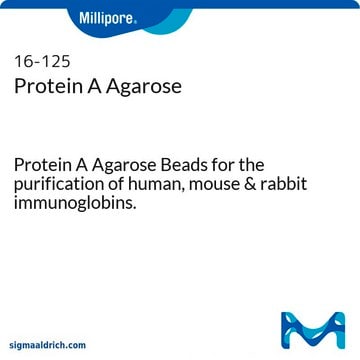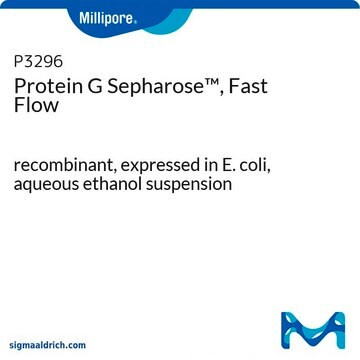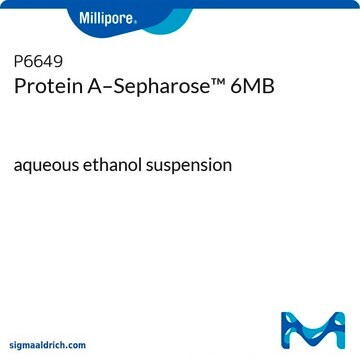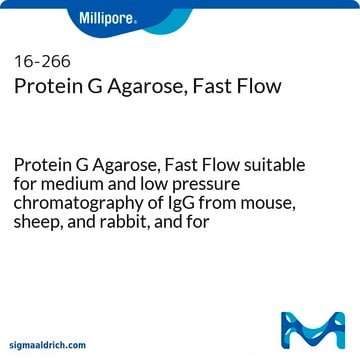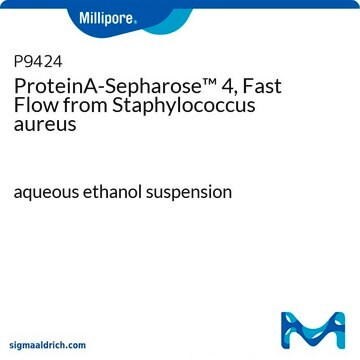16-156
Protein A Agarose, Fast Flow
Protein A Agarose, Fast Flow suitable for medium and low-pressure chromatography, immunoprecipitation and antibody purification.
Synonym(s):
Protein A resin
Sign Into View Organizational & Contract Pricing
All Photos(1)
About This Item
UNSPSC Code:
41116133
eCl@ss:
32160801
NACRES:
NA.56
Recommended Products
form
liquid
manufacturer/tradename
Upstate®
technique(s)
affinity chromatography: suitable
immunoprecipitation (IP): suitable
western blot: suitable
shipped in
wet ice
General description
Protein A is an immunoglobulin (Ig)-binding protein used to purify large amounts of IgG. It binds to the Fc part of the antibody at the CH2–CH3 interface. Protein A-agarose might be suitable for low-pressure antibody isolation.
Recombinant Protein A covalently coupled to highly cross-linked 6% agarose beads.
Binding capacity: 40mg human IgG/ml agarose
Recombinant Protein A covalently coupled to highly cross-linked 6% agarose beads.
Binding capacity: 40mg human IgG/ml agarose
Application
Protein A Agarose, Fast Flow has been used in immunoprecipitation and chromatin immunoprecipitation (ChIP).
Quality
routinely evaluated in immunoprecipitation
Physical form
sterile distilled water containing 0.01% thimerosal
Legal Information
UPSTATE is a registered trademark of Merck KGaA, Darmstadt, Germany
Disclaimer
For U.S. Customers: Contains mercury; Do not place in trash - dispose according to local, state, or federal laws.
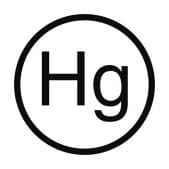

Storage Class Code
10 - Combustible liquids
WGK
WGK 1
Certificates of Analysis (COA)
Search for Certificates of Analysis (COA) by entering the products Lot/Batch Number. Lot and Batch Numbers can be found on a product’s label following the words ‘Lot’ or ‘Batch’.
Already Own This Product?
Find documentation for the products that you have recently purchased in the Document Library.
Customers Also Viewed
Vasavi Sundaram et al.
Genome research, 24(12), 1963-1976 (2014-10-17)
Transposable elements (TEs) have been shown to contain functional binding sites for certain transcription factors (TFs). However, the extent to which TEs contribute to the evolution of TF binding sites is not well known. We comprehensively mapped binding sites for
Yong Cheng et al.
Nature, 515(7527), 371-375 (2014-11-21)
To broaden our understanding of the evolution of gene regulation mechanisms, we generated occupancy profiles for 34 orthologous transcription factors (TFs) in human-mouse erythroid progenitor, lymphoblast and embryonic stem-cell lines. By combining the genome-wide transcription factor occupancy repertoires, associated epigenetic
Suzana Markolovic et al.
Nature chemical biology, 14(7), 688-695 (2018-06-20)
Biochemical, structural and cellular studies reveal Jumonji-C (JmjC) domain-containing 7 (JMJD7) to be a 2-oxoglutarate (2OG)-dependent oxygenase that catalyzes (3S)-lysyl hydroxylation. Crystallographic analyses reveal JMJD7 to be more closely related to the JmjC hydroxylases than to the JmjC demethylases. Biophysical
Human IgG Subclasses
Antibody Fc, 159-177 (2014)
Chih-Chin Huang et al.
The Journal of biological chemistry, 284(25), 17206-17215 (2009-04-15)
G protein-coupled receptor (GPCR) kinases (GRKs) phosphorylate activated GPCRs and initiate their desensitization. Many prior studies suggest that activated GPCRs dock to an allosteric site on the GRKs and thereby stimulate kinase activity. The extreme N-terminal region of GRKs is
Our team of scientists has experience in all areas of research including Life Science, Material Science, Chemical Synthesis, Chromatography, Analytical and many others.
Contact Technical Service